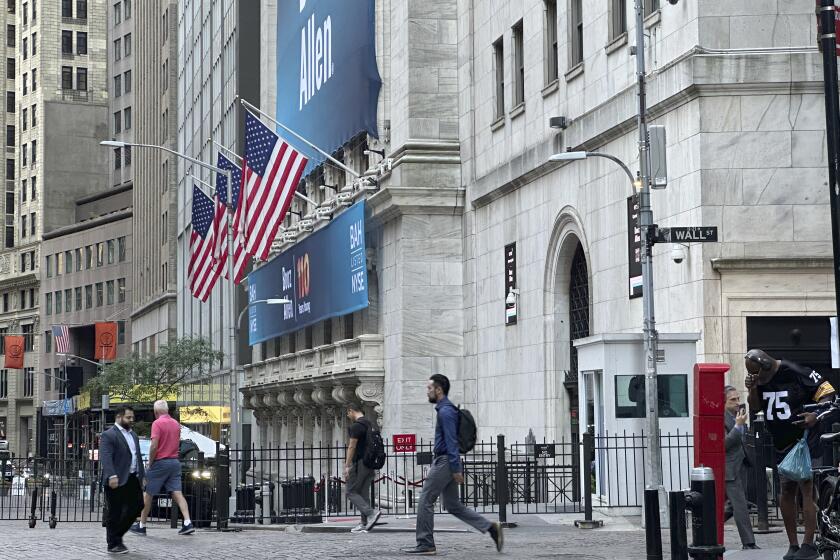Dance review: ‘Retrospective’ shows heights Trisha Brown reached
- Share via
For the brief moment that she stood atop the eight-story building at UCLA on Friday evening in the soft light of the setting sun, she looked as though she belonged there. This was, after all, the Eli and Edythe Broad Art Center, and the woman might have been, say, an Antony Gormley artwork.
She surely seemed a sculpture as she began to tip over. But once at a 90-degree angle to the ground, she walked, casually and with slow ease, down the side of the building as if this were a perfectly normal thing to do. For spectators watching from below, things became confused. Was she on level ground, or were we?
The woman was Amelia Rudolph and she was performing Trisha Brown’s “Man Walking Down the Side of a Building.” She was also figuratively pointing the way to the first of two programs in Royce Hall that formed the heart of the Trisha Brown Dance Company “Retrospective Project” put on by the Center for the Art of Performance at UCLA.
PHOTOS: Arts and culture in pictures by The Times
The choreographer has never been one for respecting solid ground. “Building” is early Brown. Originally presented in 1970 in lower Manhattan as a kind of guerrilla art activity that turned dance on its head and brought it down to earth, the piece had attained classic status Friday. Rudolph is the founder of Bandaloop, a dance company influenced by Brown that specializes in precipitous dancing. “Building” now suits a grand art building as much as does Richard Serra’s monumental UCLA site-specific “Torqued Ellipse” disorienting sculpture that proved handy for leaning against while watching Rudolph’s space walk.
Perspective was, indeed, the name of the game for the Brown retrospective. The 76-year-old pioneer in postmodern dance is no longer on the scene. Last month her company announced that the choreographer, who has had a series of strokes, would place it in others’ hands. “I’m going to toss my arms — if you catch them they’re yours,” she might well have said. That’s the title of her 2011 dance that was listed on the program Friday night as her last work.
This wasn’t the first Brown retrospective in Royce — there was one as long ago as 1990. It was not, by a long shot, her first foray into places on campus where dance may not be thought to belong. In 1975, she performed a solo work in the Ackerman Union. Nor were a number of the pieces in the current retrospective unfamiliar in L.A., some were on the bill when the company passed through the Valley Performing Arts Center two years ago.
But what was new, besides the recent work, was the context. The company, following the example of the Merce Cunningham Dance Company after its founder died in 2009, has entered into a three-year retrospective tour and then will begin licensing Brown’s works to others. We no longer view Brown’s dance as process but as history. I can’t envision any way to read “Toss” other than as farewell.
It has all the Brown trademarks. Eight dancers toss their arms and legs, yet they also congeal into regular formality. Several industrial fans on stage blow the loose fabric of Kay Boyce’s white costumes, which are eventually discarded, leaving the dancers in brightly colored bathing suits. A captivating score by Alvin Curran (heard on recording as was all the music in the two programs) has the quality of announcing new worlds — the composer blows a shofar and conveys other realms in his atmospherically original piano playing.
PHOTOS: Arts and culture in pictures by The Times
A soul separates in “Toss” from the body. We are left with the wind and the freedom.
The second program Sunday afternoon had “Rogues,” another Brown piece from 2011 for two male dancers. It uses the same Curran score (although not all of it). Two male dancers — one in orange (Neal Beasley) and one in black (Nicholas Strafaccia) — are, well, roguish, a couple of postmodern Fred Astaires. Is that a farewell as well? If so it is less Buddhist and more showbiz, leaving ‘em wanting more.
A third work from 2011, “Les Yeux et l’Âme,” is set to the instrumental dances in Rameau’s 1748 ballet “Pygmalion.” It hints at Brown’s extraordinary earlier foray into Baroque opera with her production of Monteverdi’s “L’Orfeo” in 1998. Far less extravagant (no flying), her Rameau is understated and exquisite. Significantly, three decades after “Building,” Brown was still bringing, with the Pygmalion myth, statues to life.
The earlier works on the two programs were the high-spirited “Set and Reset” (1983), with exuberant sets and costumes by Robert Rauschenberg and a Laurie Anderson score, the early Brown solo “Watermotor” (1979) elegantly danced here by Samuel Wentz, the glittery “Foray Forêt” (1990) with the sounds of the Hamilton High School Marching Yankee Band intentionally drifting into the theater from the lobby, the hilarious “Spanish Dance” (1973) set to Bob Dylan’s recording of “Early Mornin’ Rain,” and “Newark (Niweweorce),” a collaboration in pure Minimalism with the artist Donald Judd and the composer Peter Zummo.
Five years ago, Brown displayed her spidery, geometric drawings in an exhibition she titled “So That the Audience Does Not Know Whether I Have Stopped Dancing.” We now know. But the dance goes on. And it has never looked better.
MORE
INTERACTIVE: Christopher Hawthorne’s On the Boulevards
Depictions of violence in theater and more
PHOTOS: Arts and culture in pictures
More to Read
The biggest entertainment stories
Get our big stories about Hollywood, film, television, music, arts, culture and more right in your inbox as soon as they publish.
You may occasionally receive promotional content from the Los Angeles Times.











